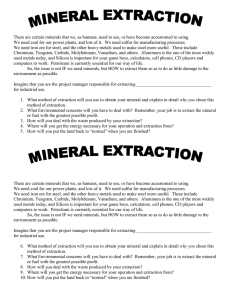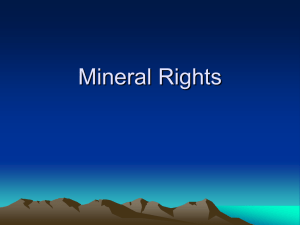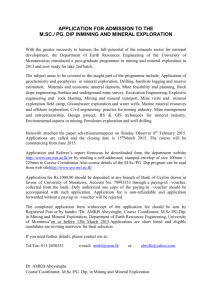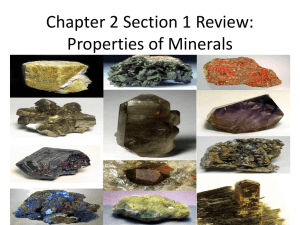Role of Economics
advertisement
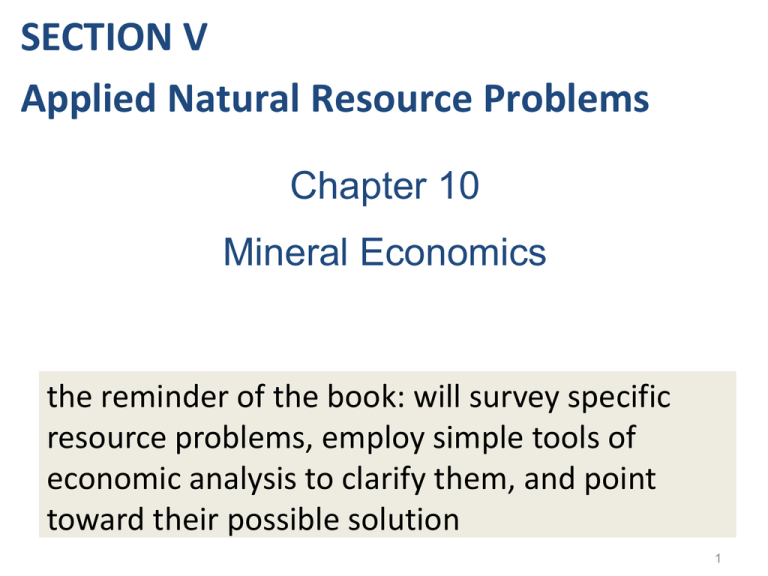
SECTION V Applied Natural Resource Problems Chapter 10 Mineral Economics the reminder of the book: will survey specific resource problems, employ simple tools of economic analysis to clarify them, and point toward their possible solution 1 Minerals: Nonrenewable Resources (S1 = S0 – Q0) • Inorganic solid substances that are found in or on the ground and are used by humans • Categories: fuel minerals—coal, oil, natural gas ores—iron, nickel… metals nonfuel minerals precious metals—gold... industrial minerals—natural aggregate, cement, fertilizer minerals, abrasives, and gemstones 2 1. Geological Factors and Costs of Extraction • Figure 10-1, page 171 – As the mineral grade (mineral content per quantity of material) decreases, known and expected quantities of mineral increase – As the grade decreases, the costs of extraction and refining increase – Two essential questions: the socially efficient rate at which the deposit should be used up? the economically efficient rate at which geological exploration should be pursued? 3 2. Extraction Economics for a Known Stock • The two-period example: Present value of net benefits (PVNB) = Net benefits in year 0 + [1/(1+r)] (Net benefits in year 1) • Solving for intertemporal efficiency means to maximize PVNB, then: d ( PVNB ) ( dq 0( dB 0 dC 0 dq 0 dq 0 dB 0 dC 0 dq 0 ) ) dq 0 0 ( p 0 MC 0 ) 1 ( dB 1 1 r dq 1 1 ( dB 1 1 r dq 1 1 1 r dC 1 ) dq 1 dC 1 ) dq 1 ( p 1 MC 1 ) 4 p 0 MC 0 1 1 r ( p1 MC 1 ) Since r > 0, [1/(1+r)] < 1, so, (p1 – MC1) > (p0 – MC0). See Figure 10-3, on page 174: q0 + q1 = 160 + 140 = 300. 5 • Conclusion 1: q0 > q1 – The dynamically efficient production profile involves a “tilt” toward the present, in the sense that extraction in the first year exceeds that of the second year • Conclusion 2: (go back to slide 4) the resource rent rises at the rate of discount r 0 ( p 0 MC 0 ) ( p 0 MC 0 ) rent 0 rent 1 1 1 r 1 1 1 r ( p1 MC 1 ) ( p1 MC 1 ) rent 1 1 r (1 r ) rent 0 6 • Conclusion 3: (go back to slide 4) user cost = – 1 1 r ( p1 MC 1 ) 7 A Review Question Let the inverse demand functions of the two periods be: p0 = 15 – q0 and p1 = 15 – q1. Let the marginal extraction costs be MC0 = 5+q0 and MC1 = 5 + q1. p = MC in each period occurs at q=5, so if the total quantity is 10 or more, there is essentially no intertemporal problem, at least if our horizon is limited strictly to two time periods. But suppose there is a limitation, say q0 + q1 ≤ 8. A flat production profile would have q0 = q1 = 4. But this cannot be efficient if there is a positive discount rate. Suppose there is. Show the production profile is tilted toward the present (use a 10% discount rate). 8 3. Mineral Prices in Fact • Figure 10-5, p.177: 9 minerals, 1902-1998, the US • up-and-down movement, but overall drop in prices – The market simply does not see a quantitative restriction in these resources in relevant human-scale time frame – Technical change along the whole continuum of natural resource exploration, discovery, development, extraction, transportation, and processing • The recent upward swing in mineral prices since 2006 is the surging demand from developing countries 9 4. Resource Exploration and Development • Exploration and development can increase the inventory of known deposits • Better exploration methods can make it possible to extract resources of lower grades and thus to expand reserves • Figure 10-6, p.179: MC of expanding reserves; demand for reserves – Reductions in extraction costs (due to technological changes) have occurred faster that demand increase, driving prices down 10 5. Nonrenewable Resources and Sustainability • How can nonrenewable resources (minerals) be used in a sustainable fashion? – we will eventually shift to a substitute resource of greater abundance (like solar energy) – Invest the resource rents earned from current mineral extraction into physical capital (tractors,…) and human capital 11 6. U.S. Mineral Import Dependence and Other Policy Issues • Table 10-2, p.182: mineral imports as a percent of consumption show the heavy dependence on imports to supply domestic demands • The 1872 Mining Law (still in effect) – set up the claim and patent system so that prospectors can fill claims on public land found to contain economically significant mineral deposits and convert it to private ownership at low prices – Suggestion: levy a federal royalty—a tax of x percent of the net value (price minus extraction costs) of a mineral delivered to the processing plant 12
